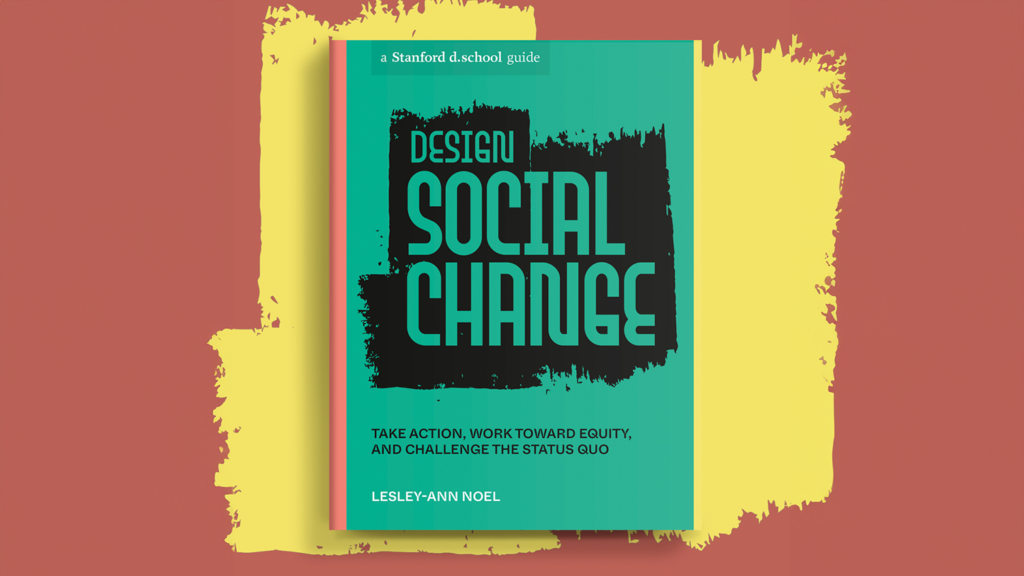Lesley-Ann Noel is an assistant professor of media arts, design and technology at the College of Design. As one of the newest installments of Stanford d.school’s book collection, “Design Social Change” was written as a guide for topics, mindsets and principles that designers can use to drive the way they think about change using a cooking metaphor she’s developed over the last five years.
She started using this metaphor as she noticed how some people followed design methods faithfully as if they were trusted recipes, while others, possibly more confident or more chaotic chefs, just threw ingredients together and improvised their design processes as they went along. In this book, she focused on recipes for making social change.

Who is this book for? What impact do you hope the book makes on its reader?
I thought of two audiences as I wrote the book:
a) people who think they are powerless or can have little impact on the world, to encourage them to see that they have more power, agency and impact than they might think, and
b) people who may have power for them to see where they need to share power, learn to listen and learn to see so they can also support change in the world.
It’s not a textbook. It’s meant to be an accessible guidebook or handbook. Though the book is design-based, and also based on academic theory, it uses very accessible language, and both my 16-year-old son and my 78-year-old mother read it and gave it a thumbs up!
Describe the process of writing this book. What ideas and experiences did you pull from?
This book started as a cookbook about change. I wanted to encourage people to use theoretical approaches to social change grounded in the work of [Brazilian educator and philosopher] Paulo Freire but did not want to write an academic textbook. I wanted to use very accessible language and metaphors about cooking and painting so that people could understand design, oppression, liberation and other similar concepts.
I wanted people to think that making change could be as easy as following a recipe and combining ingredients. I also wanted people to see that they could personalize the recipes to suit their needs and taste. The food analogy was meant to be very accessible.
As I wrote, the food analogy became less prominent, but you can still pick it up as you read. I hope people still reflect on the steps or ingredients that can start them off in designing social change: critical awareness, deeper emotional intelligence, and a focus on equitable futures. Of course, this book is just a starting point, but I hope it leaves people wanting to change the world.
Can you share a short preview of one of the “recipes” for design?
The ‘recipes’ are short essays about topics, mindsets, and principles that we can use to drive the way we think about change.
My favorite recipes are about anger and joy. I’ve also gotten a lot of feedback from people that resonated with those recipes as well. I describe anger as a spice that fuels change, and joy as a spice that creates balance when faced with challenges.
I’ve worked in the social design space for a few years and have found those two ‘ingredients’ much needed in the work I do. Anger is often feared, but we can learn to read it, and use it to move the work forward, while joy is often forgotten, and when we understand how to make and sustain it, it makes the work better.
Do the lessons shared in this book carry over to your classroom at the College of Design? If so, how?
The book is loosely based on some of my Ph.D. work, so people who followed my doctoral work, which I did here at NC State between 2015 – 2018, will recognize a lot of the content. Several themes from my doctoral work have been carried through in the courses that I teach.
Students in ADN 418 – Contemporary Issues in Art and Design will recognize quite a bit of the content and discussions around oppression and making change, while students from Design Process and my Art and Design International Studio, might also recognize the content and activities in Part 3 of the book, which is about building equitable futures. The themes of our agency as designers, and our ability to impact social change are themes through both my classes and research.
“Design Social Change” is published by Stanford University’s d.school, and is available for purchase on Amazon, Bookshop.org and MATTER.
- Categories:



